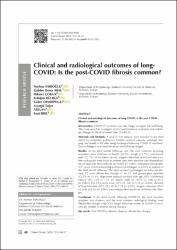Clinical and radiological outcomes of long- COVID: Is the post-COVID fibrosis common?

Göster/
Erişim
info:eu-repo/semantics/openAccessTarih
2023Yazar
Sarıoğlu, NurhanAksu, Gülden Deniz
Çoban, Hikmet
Bülbül, Erdoğan
Demirpolat, Gülen
Arslan, Ayşegül Tuğçe
Erel, Fuat
Üst veri
Tüm öğe kaydını gösterÖzet
Introduction: COVID-19 survivors may take longer to regain full well-being. This study aimed to investigate clinical and functional evaluation and radiolo- gic changes in the third month after COVID-19. Materials and Methods: A total of 126 patients were assessed in the third month for symptoms, pulmonary function, exercise capacity, radiologic ima- ging, and quality of life after being discharged following COVID-19 treatment. Two radiologists evaluated the initial and follow-up images. Results: At the third month follow-up visit, the most common persisting symptoms were shortness of breath (32.5%), cough (12.7%), and muscle pain (12.7%). At the follow-up visit, oxygen saturations at rest and after a six- min walking test were lower in patients with prior intensive care hospitalizati- on compared to those without (p< 0.001, p= 0.004). Computed tomography (CT) scans revealed persisting pulmonary pathologies in 64.6% of patients at the third month follow-up. The most common pathologies on follow-up tho- racic CT were fibrotic-like changes in 44.2% and ground-glass opacities (GGO) in 33.3%. Regression analysis unveiled that age [95% confidence interval (CI), 1.01 to 1.15; p= 0.020], male sex (95% CI, 4.06 to 95.3, p< 0.001), first CT severity score (95% CI, 1.02 to 1.41, p= 0.028), duration of hospitalization (95% CI, 1.02 to 1.18, p= 0.012), oxygen saturation (95% CI, 0.86 to 0.96, p< 0.001) were independent predictors of fibrotic-like chan- ges. Conclusion: In the third month following COVID-19, the most common symptom was dyspnea, and the most common radiological findings were fibrotic-like changes and GGO. Longer follow-up studies of COVID-19 survi- vors are needed to observe lasting changes. Giriş: COVID-19 geçirenlerde tam iyilik haline kavuşma uzun sürebilmektedir. Bu çalışmada COVID-19 sonrası üçüncü ayda klinik ve fonksiyonel değerlendirme ve radyolojik değişikliklerin incelenmesi amaçlanmıştır. Materyal ve Metod: COVID-19 tanısıyla taburcu edilen ve üçüncü ay kontrol vizitine gelen 126 hasta semptomlar, solunum fonksi- yonları, egzersiz kapasitesi, radyolojik görüntüleme ve yaşam kalitesi ile değerlendirilmiştir. İki radyolog tarafından ilk ve kontrol görüntülemeleri karşılaştırarak incelenmiştir. Bulgular: Üçüncü ay kontrol vizitinde en sık devam eden semptomlar, nefes darlığı (32,5%), öksürük (12,7%) ve kas ağrısı (12,7%) idi. Öncesinde yoğun bakım yatışı olan hastaların kontrol vizitinde, istirahatte ve altı dk yürüme sonrası bakılan oksijen satürasyonla- rı yoğun bakım yatışı bulunmayanlara göre daha düşüktü (p< 0,001, p= 0,004). Bilgisayarlı tomografi incelemeleri üçüncü ayda hastaların %64,6’sında radyolojik patolojilerin devam ettiğini ortaya koydu. Kontrol toraks bilgisayarlı tomografide en sık gözlenen bulgular %44,2’sinde fibrotik benzeri değişiklikler ve %33,3’ünde buzlu cam opasiteleri (GGO) idi. Yaş, [%95 güven aralığı (CI), 1,01 ile 1,15; p= 0,020], erkek cinsiyet (%95 GA, 4,06 ile 95,3; p< 0,001), ilk BT şiddet skoru (95% GA, 1,02 ile 1,41; p= 0,028), hasta- nede yatış süresi (%95 GA, 1,02 ile 1,18; p= 0,012), oksijen satürasyonu (%95 GA, 0,86 ile 0,96; p< 0,001) fibrotik benzeri deği- şiklikler için bağımsız belirleyiciler olarak saptandı. Sonuç: COVID-19 sonrası üçüncü ayda en sık görülen semptom nefes darlığı, en sık görülen radyolojik bulgu ise fibrotik benzeri değişiklikler ve buzlu cam opasiteleridir. Kalıcı değişiklikleri gözlemlemek için COVID-19 geçirenlerde daha uzun süreli takip çalışma- larına ihtiyaç vardır.
Cilt
71Sayı
1Bağlantı
https://doi.org/10.5578/tt.20239907https://search.trdizin.gov.tr/yayin/detay/1176794
https://hdl.handle.net/20.500.12462/14069

















